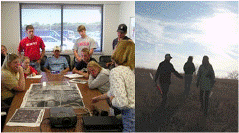Environmental and Sustainability Studies Program

Department of Environmental Studies: Undergraduate Student Theses
Date of this Version
2020
Document Type
Thesis
Citation
Environmental Studies Undergraduate Student Thesis, University of Nebraska-Lincoln, 2020.
Abstract
In a time where pests such as emerald ash borer are reducing urban forests, it is important to gain a return on investment for new trees planted. Since trees cost money, the value of the ecosystem services that they provide over the course of their lives should outweigh their costs. Due to the need for a return on investment, it is important to know whether newly planted street trees are being planted in a space that does not inhibit their growth or ability to provide benefits. This study, in Lincoln, NE looks to determine the relationship between a street tree’s planting space width and its ability to grow and provide ecosystem services. By measuring DBH, LCR, canopy width, height and planting space width from two species, in both parks and trees, and using i-Tree to calculate benefits, the relationship between planting space width and canopy width and benefits can all be modelled using a series of linear regressions. In the end, it was found that both canopy width and benefits were largely unaffected by planting space width, but further studies involving age could provide a better picture of the relationship relative to age.
Included in
Environmental Education Commons, Natural Resources and Conservation Commons, Sustainability Commons


Comments
Copyright 2020 Ryan Kendall